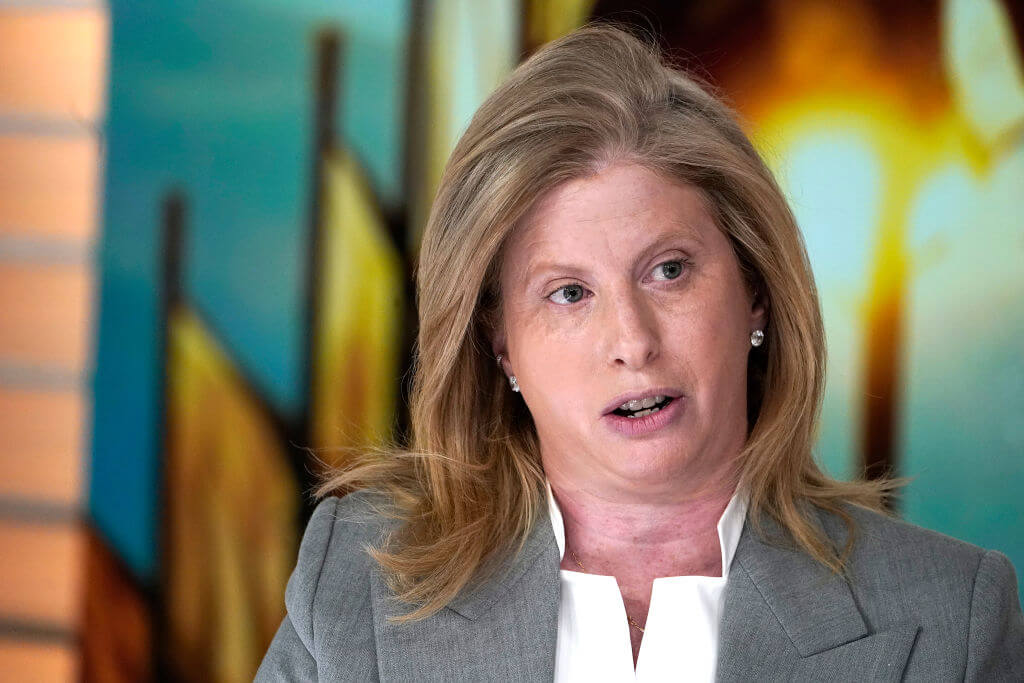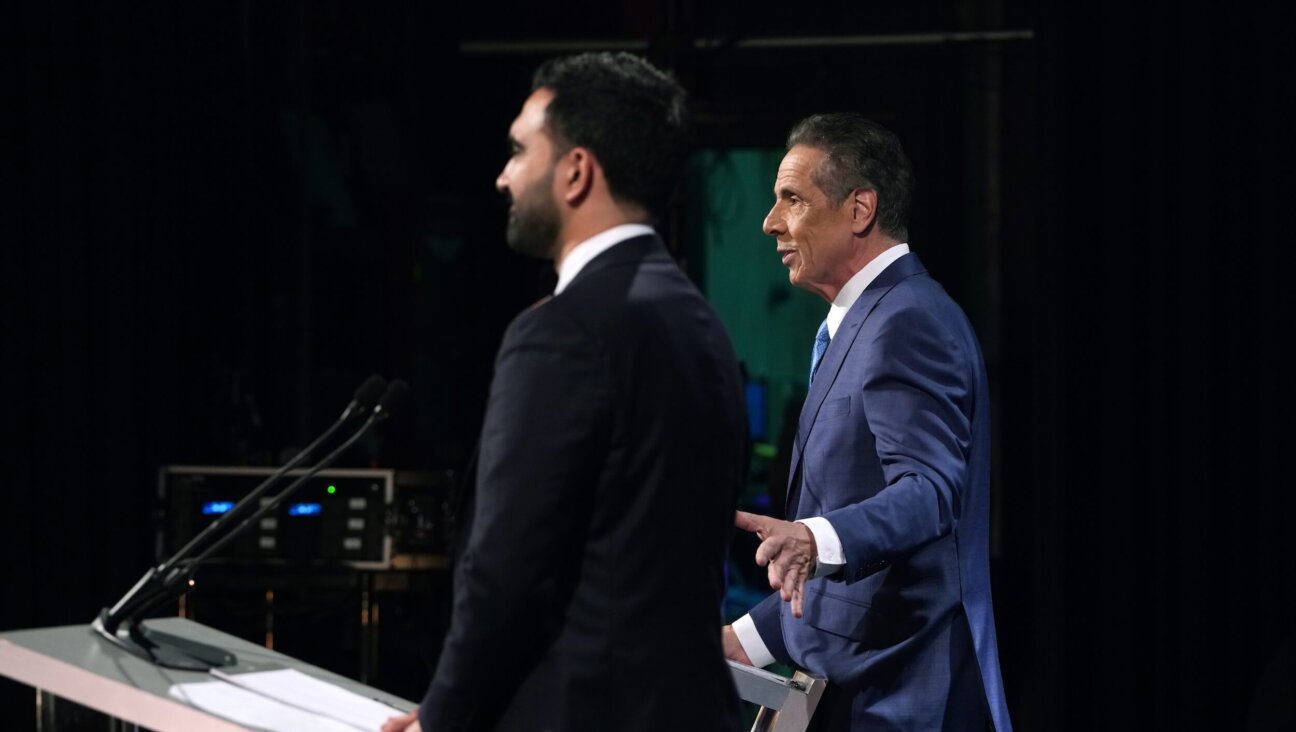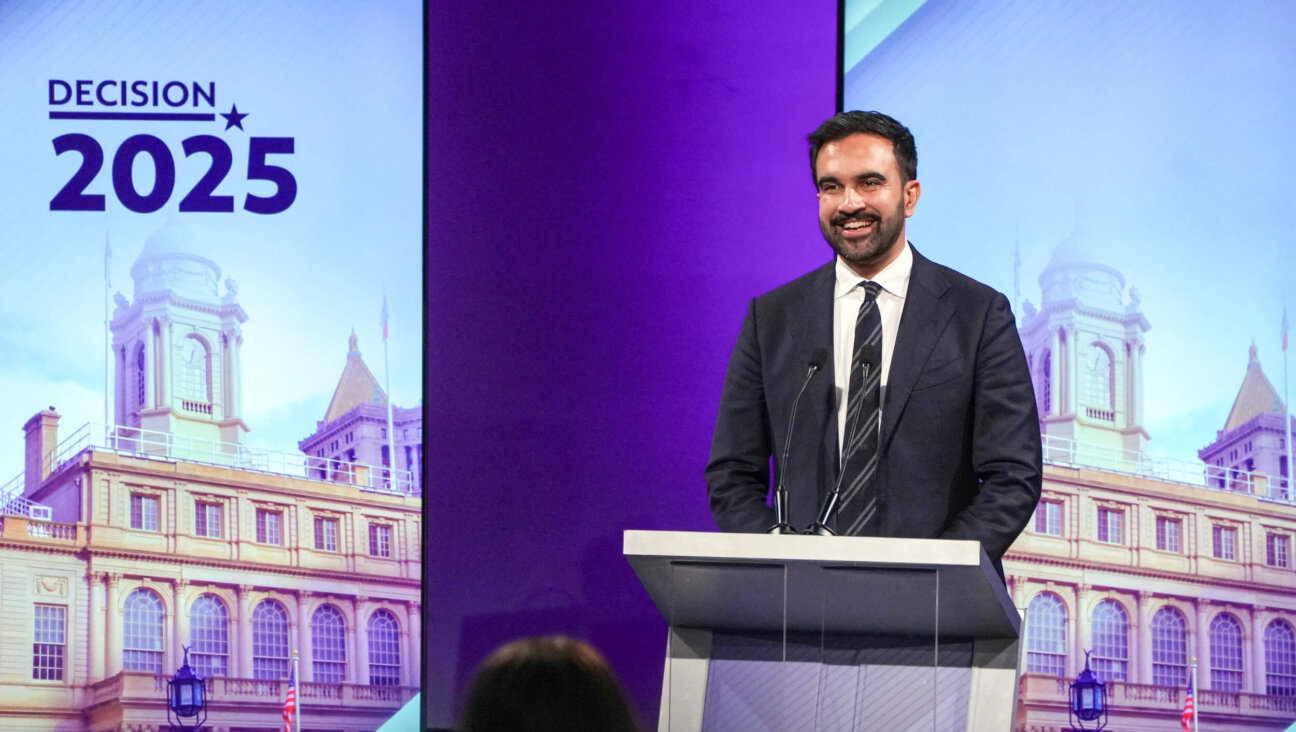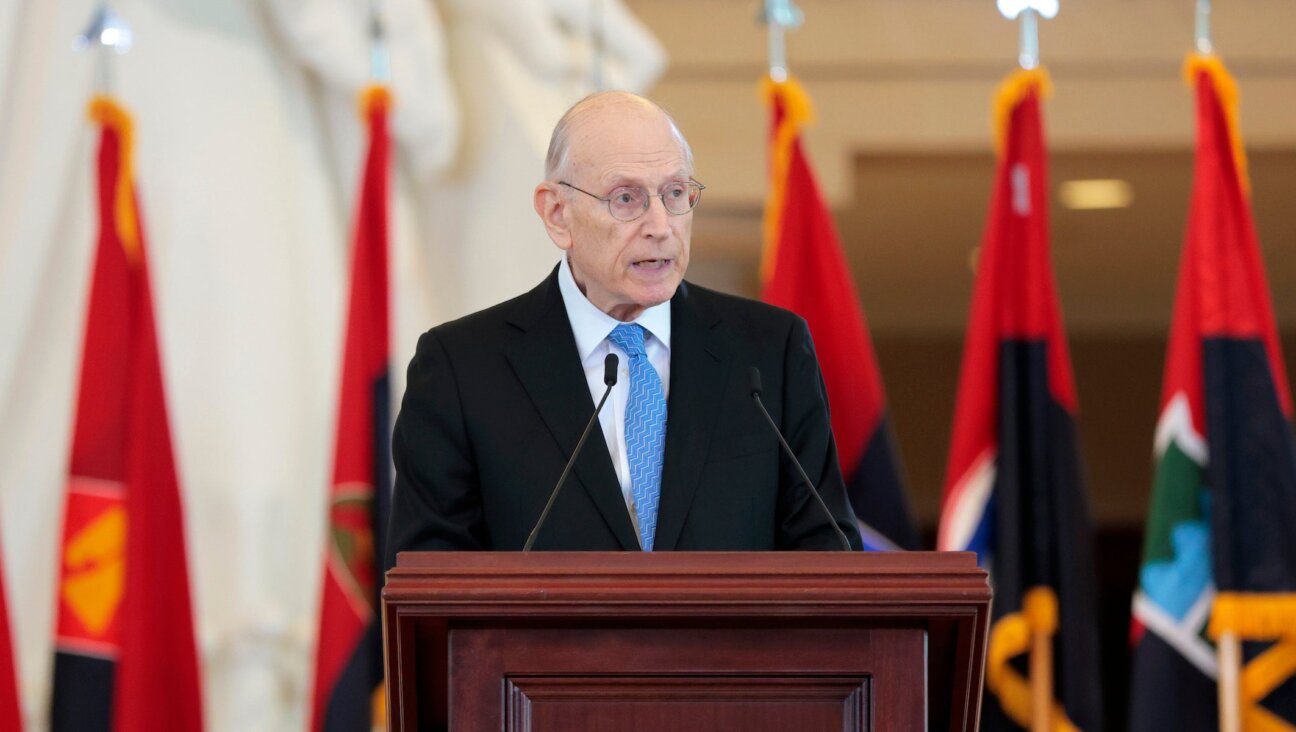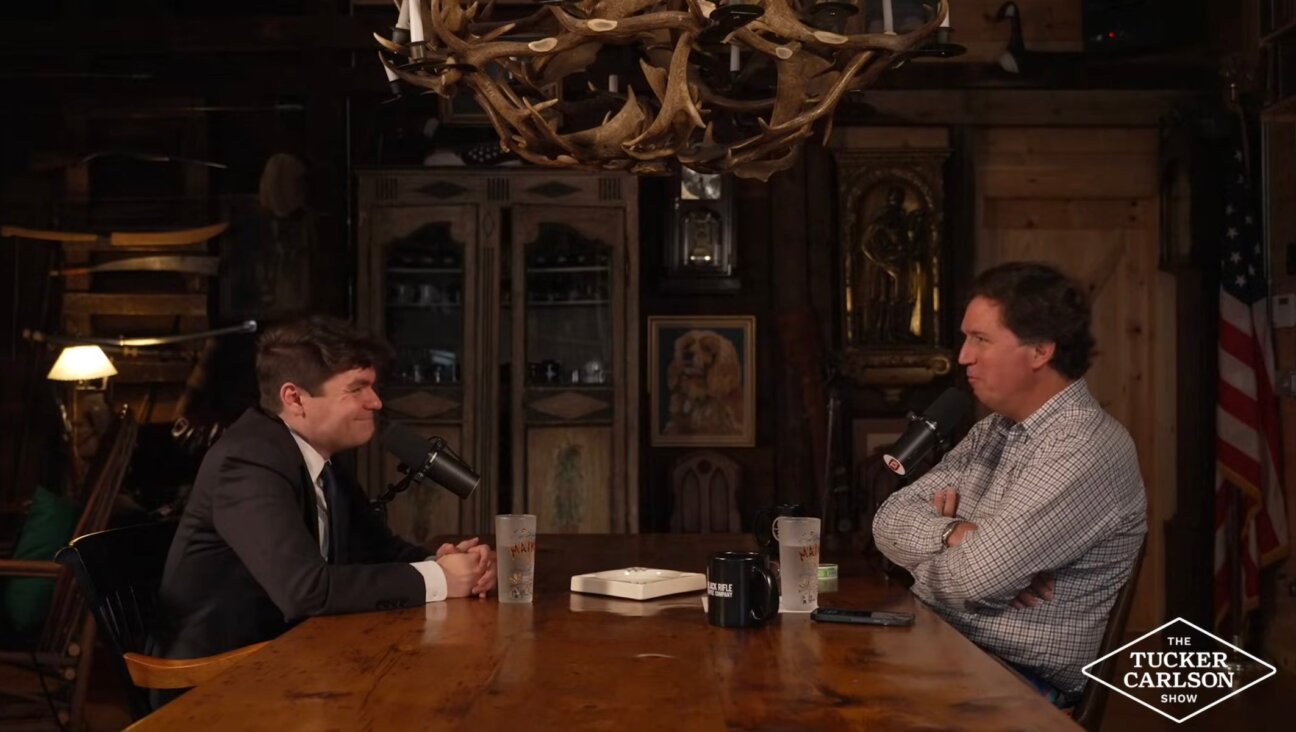Washington’s Best-Traveled Synagogue Gets Ready To Move Again

Image by Courtesy Jewish Historical Society of Greater Washington
The first time the historic Adas Israel synagogue stood in the way of progress, it occupied the corner of Sixth and G Streets NW in downtown Washington.
During the 1960s, the Washington Metropolitan Area Transit Authority bought the Sixth and G Street block and began demolishing buildings to make way for its new headquarters.
By then, Adas Israel, which opened in 1876, had long since ceased to be a Jewish house of prayer. But historic preservationists recognized its importance as the oldest synagogue building in the nation’s capital and also as the site of the first Jewish service attended by a sitting U.S. president.
A few members of the Jewish Historical Society of Greater Washington, which had formed only a few years earlier, in 1960, decided to rescue the building.
They had the synagogue listed on the National Register of Historic Places, secured a federal grant of $100,000 and raised a further $100,000 themselves. They also persuaded federal and local officials to acquire the building from its then owner and to lease a plot of land to the society a few blocks away for a nominal rent of $1 a year.
Then, over several days, culminating in a freezing December morning in 1969, they watched as first the synagogue was slowly raised on a hydraulic press and eventually dragged by two Caterpillar track construction vehicles east along three city blocks to Third and G Streets.
Early next year, the synagogue will be lifted off its foundation once again, making it perhaps the best-traveled synagogue in the country.

Image by Courtesy Jewish Historical Society of Greater Washington
This time, the Adas Israel synagogue stands in the way of a $1.3 billion development project to reconnect Washington’s downtown grid by building a commercial and residential complex over the top of Interstate 395 that will reconnect F and G streets between Second and Third Streets.
Sometime between January and March 2016, Adas Israel will be placed on an adjacent triangle of land. Then, in 2019, it will be transported one block south to the corner of Third and F Streets, where it will be dwarfed by the new gleaming complex known as Capitol Crossing.
It’s an engineering feat that will surely attract a crowd, as well as media attention. But it will also be a pivotal moment for the Jewish Historical Society of Greater Washington, which for the past 40 years has used Adas Israel as a museum and programming space.
As part of its move, the society plans to build an adjacent home up to five stories in height, that will cover about 30,000 square feet and will be interconnected with the historic synagogue.
The expansion will vault the historical society into the same league as midsize Jewish museums like the William Breman Jewish Heritage Museum, in Atlanta, and the Jewish Museum of Maryland, in Baltimore.
The historical society’s executive director, Laura Cohen Apelbaum, said the leap to a full-fledged, purpose-built museum is daunting. “There is a lot to worry about,” she said. “But if you don’t take a risk on anything, you are just standing still.”
•
Adas Israel has its roots in Washington’s first Jewish community, Washington Hebrew Congregation, which was founded in the early 1850s by a group of Jews from southern Germany.
They worshipped in each other’s homes and then in rented halls until, in 1863, they purchased their first building, the 500-seat Methodist Episcopal Church on Eighth Street between H and I Streets NW.
Washington Hebrew began life as an Orthodox congregation. But it quickly began to reform, causing friction between progressive and traditional members of the community.
Some prayers were recited in German or in English, other prayers were dropped from the service altogether. The breaking point came when the congregation decided to buy a small organ, called a melodeon, to accompany its choir.
More than 30 Orthodox families resigned from the congregation, forming their own group, Adas Israel, in 1869. They met in rented spaces for a few years, and soon after they decided to build a synagogue of their own.
Adas Israel set for itself a goal of opening its new building in time for the centennial. By June 1876, the small congregation had succeeded in buying a plot of land at the corner of Sixth and G Streets NW and in erecting the first purpose-built synagogue in America’s capital.
Many congregations of the day chose Moorish-inspired designs for their synagogues, characterized by domes and arches. But Adas Israel’s founders opted for a simple, red-brick Romanesque-inspired synagogue with long round-headed windows, which one newspaper of the day, The Jewish Messenger, described as “little, neat and unpretentious.”
The building, which was about 25 feet wide and 60 feet deep, had on its first floor a classroom and a mikveh, and on the second floor a sanctuary and a women’s gallery that could seat a total of about 100 people.
At its dedication, on Friday, June 9, the sanctuary was filled with flowers, the ark was flanked by American flags. At the front of the sanctuary, on rented sofas just before the bimah, sat the president of the United States, Ulysses S. Grant; his son Ulysses Jr.; acting Vice President Thomas Ferry, and other dignitaries.
The American Jewish historian Jonathan Sarna believes that Grant’s appearance was particularly symbolic, taking place just one month before the celebration of America’s centenary. “It announced that Judaism was a co-equal religion in the United States,” Sarna wrote in his latest book, “When General Grant Expelled the Jews.”
As the title of Sarna’s book suggests, Grant had a complex relationship with America’s Jewish community.
As a Civil War general, Grant was responsible for General Order 11, banning Jews from the theater of war. The order was revoked within a few weeks by President Lincoln, but it dogged Grant for the rest of his life. In an email to the Forward, Sarna said there is “no question in my mind that [Grant’s] decision to attend [the synagogue dedication] was motivated by his continuing guilt” over General Order 11.
The president did more than just sit through the entire three-hour ceremony, much of it conducted in Hebrew; he also donated $10 — the equivalent of about $200 today — toward the synagogue’s building fund.
Just a few decades later, at the turn of the 20th century, Adas Israel had already outgrown its building. In 1905 the congregation sold the synagogue to a local real estate developer and built a bigger synagogue, with a capacity of 800, a few blocks away at Sixth and I Streets.
During the early 1900s, I Street was a hub of Jewish activity, with synagogues at Fifth, Sixth and Eighth Streets. Rabbi Stanley Rabinowitz wrote in an article for the historical society in 2001 that the neighborhood was very lively, “especially on Yom Kippur, when young people who should have been at worship were instead socializing on I Street.”
As the Jewish community became more affluent, its members began to migrate northwest toward the city’s suburbs and into parts of Maryland. In 1945, Adas Israel bought a plot of land 4 miles away, in Cleveland Park, and in 1951 it sold its building at Sixth and I Streets to a church.
Downtown’s two remaining congregations had both moved north by 1960.
The historic Adas Israel synagogue building, meanwhile, went through several transformations.
During the first half of the 20th century, the sanctuary was leased to a succession of churches while the ground floor was converted into three separate shop fronts that at various times housed, among other businesses, a barber shop, a bicycle shop and a barbecue restaurant.

Image by Courtesy Jewish Historical Society of Greater Washington
A photograph taken during the 1950s shows a “Bar B Q” sign, with an image of a pig, hanging on the side of the building. When the last church congregation moved out, the sanctuary was converted into storage space for the ground floor businesses, and a janitor turned the synagogue’s ark into a broom closet.
•
Apelbaum was just 35 years old when she was hired, in 1994, to lead the Jewish Historical Society of Greater Washington.
On paper, Apelbaum seemed like an odd fit. She was trained in law and taxation and had worked for the IRS and on real estate and tax issues for the District of Columbia.
But Apelbaum’s passion was for American Jewish history and for historic preservation.
A fourth generation Washingtonian Jew, Apelbaum grew up in the Maryland suburb of Chevy Chase and developed a passion for Jewish history at the B’nai B’rith’s Klutznick Jewish Museum, housed in the service group’s world headquarters on Rhode Island Avenue.
In 1992, Apelbaum joined the museum’s board, where she spent a couple of years organizing events to attract more young visitors to the museum.
When she was hired two years later to run the Jewish Historical Society of Greater Washington, Apelbaum became the society’s first full-time executive director.
At the time, the society had a budget of $140,000 and borrowed most of the objects it needed to mount exhibitions and then returned them to their owners as the exhibitions closed.
The society’s crown jewel, then as now, was the historic Adas Israel synagogue building.
During a recent visit to the historical society’s administrative offices in Washington, now housed in a building the society bought in 2008 one block from the synagogue, Apelbaum told me that the moment she stepped into the sanctuary, “I just felt… this history deserves more; we need to do a better job presenting it, and we need to do more outreach to the community.”
During her first years running the society, she mounted a slew of exhibitions examining Jewish life in the capital, from women’s charity work to the ambassadorial career of Yitzhak Rabin. She also ramped up the society’s fundraising, with special luncheons and educational events.
The historic Adas Israel building has been an awkward centerpiece of the society’s collection.
Apelbaum said that the building’s rescue is the society’s greatest coup as well as the reason why the new museum project will finally take off. But she said that the synagogue’s size and its location have been a hindrance.
Despite its downtown address, the building feels hidden, tucked away at the end of a series of one-way streets and bordered by the freeway.
The synagogue’s sanctuary is small and simple. Fewer than 10 short wooden pews line the center of the room, flanked by slender blue-gray columns and several interpretative panels explaining the synagogue’s history and the history of the Jews of Washington.
Apelbaum said that the sanctuary can feel full with as few as 35 people inside it, and that she limits events to 60 people. For larger historical society exhibitions and events, the society partners with other local institutions.
The society drew more than 250 people to the National Archives for a talk on Grant by Sarna. One recent winter, 350 people braved an ice storm to attend the opening night of a historical society exhibition celebrating the city’s role in the Soviet Jewry movement at Washington Hebrew Congregation in Cleveland Park.
The society organizes walking tours, special exhibitions, lectures, and student and adult education programs. Apelbaum estimates that it serves between 5,000 and 10,000 visitors a year.
During her leadership, and enabled by her ceaseless fundraising, the society has hired a curator, an archivist, a director of special projects and an office coordinator.
Its archives, which run from 1850 to the present day, include family, business and organizational documents, Judaica, and thousands of photographs.
Apelbaum doesn’t focus on the society’s collection alone. She is dogged about preserving the Jewish history of Washington in general.
When, in 2002, she learned that Adas Israel’s Congregation’s second synagogue building, at Sixth and I Streets, was up for sale, she launched what she described as a “one woman crusade.”
There was talk that a developer would turn the former synagogue, which had most recently been used as a church, into a nightclub. Apelbaum persuaded a group of Jewish developers to buy the building and by 2004 it had been renovated and rededicated as the Sixth & I Historic Synagogue.
Today, Sixth & I hosts multidenominational services and arts and cultural events aimed at the 20- and 30-something Jews who have been drawn back to the downtown area.
For the first four years after Sixth & I’s renovation, the historical society ran its office and archive out of the building. But Apelbaum said that ever since she started working at the society, her goal has been to build a dedicated museum.
It has taken more than 20 years and a stroke of luck — the Capitol Crossing project — to bring that dream so close to fruition.
Capitol Crossing’s developer, Property Group Partners, will provide the parcel of land for the synagogue and the museum. It is also underwriting the cost of moving the synagogue as well as making a contribution — Apelbaum won’t say how much — toward the cost of the museum project.
The society is still in the final planning stages for its museum, seeking estimates for construction and talking to exhibition designers. Apelbaum said the expectation is that the core exhibition will focus on the social, political and economic issues that have shaped Washington’s Jews and on the way in which Washington’s Jews have shaped the city and the nation.
The opening of the museum, which is expected to be some time around 2021, will be particularly important for the city following the decision by B’nai B’rith earlier this year to donate its entire Klutznick collection to the Skirball Museum, in Cincinnati.
(True to form, Apelbaum arranged for the Skirball to loan any Washington-related items, such as a typewriter used by sports reporter Shirley Povich, to the society’s collection.)
Sam Brylawski, president of the historical society’s board, said that the group will need to raise an additional $15 million to $20 million for the new building. A study identifying a more precise figure will be published this fall.
Brylawski said the society’s aspiration is to create a museum that will be compelling in terms of both its architecture and its exhibitions.
But he added that the group is also anxious to create a museum that is economically sustainable. “We want it to be a building that will be here a long time,” he said.
Contact Paul Berger at [email protected] or on Twitter, @pdberger



